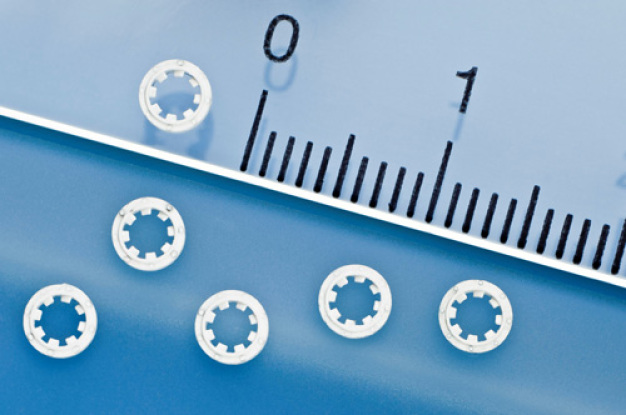Sigmasoft® Delivers First-Shot Success in Powder Injection Micro-Molding Application
Simulation supports part quality control and avoids expensive tooling rework
A micro wheel developed for a turbine guide shows how simulation with Sigmasoft® in PIM applications can significantly reduce the manufacturing costs and reliably predict in-molded defects early and at low cost in the design stage.
Miniaturization is one of the key demands in industries like electronic, medical or automotive, but when part dimensions decline drastically, the geometrical complexity increases proportionally and functional integration comes as an additional demand. The manufacturing of such complex-shaped micro-applications becomes challenging and hence a perfect target for powder injection molding (PIM) technology.
Micro-molding of MIM and CIM applications is not new to the industry. However industrial applications are rarely found outside the academic environments. One reason for this hesitation might be based on the uncertainties and challenges in quality control posed by the extremely small dimensions.
Even in macroscopic PIM applications, the quality inspection of green parts is often skipped to the sintered stage, with costly consequences. Micro-PIM brings this question to a next level: how can molded-in defects be determined reliably but with acceptable cost and time effort, for part with edge lengths of 1 to 2 mm and functional dimension of just some tenth of a mm? “The answer is in a well-structured part and mold design phase, with sufficient time for thorough design iterations based on simulation results. This time spent in the beginning is saved later multiplicatively”, explain Dr. Marco Thornagel, from Sigma Engineering GmbH, and Jochen Heneka and Tobias Müller, from the Karlsruhe Institute of Technology (KIT) in their paper Micro-Molded CIM-Components: Simulation based Mold- and Process Development, presented at the EuroPM 2013 Conference in Gothenburg, Sweden.
The paper describes the successful design process of a turbine guide wheel made of ZrO2. During mold design significant effort was spent to simulate the thermo-rheological behavior of the complete mold and to predict the later green part properties. Based on the recommendations derived from simulation results, the runner layout was optimized, the feasibility of the mold design proved, the mold built and successful micro CIM parts produced, with the impressive result that the mold stably delivered flawless parts with over 99% of theoretical density right from the first shot, without requiring tooling rework.
Thinking powder, thinking micro
Since 2009 the injection molding simulation software SIGMASOFT® has been available specifically for CIM applications. The integration of a rheological model which accounts for the viscosity increase at low shear rates increases the reliability of the predicted flow front. Also the state-of-the-art flow solver technology, able to accurately predict kinetic flow effects such as jetting, reveals the driving forces behind such phenomena and thus makes it possible to control their appearance and the part quality defects associated.
Micro dimensions create specific challenges, as they influence properties such as surface tension, heat transfer or surface-to-volume ratio. These variations require specifically developed material models to be integrated into the simulation. SIGMASOFT® has been adapted specifically for the simulation of micro-applications through material models validated over the years in several research projects.
Molds used in micro injection molding, and particularly in micro-powder injection molding, need to fulfill special requirements in terms of quality and precision. For example, a variothermal process control needs to be conducted, and vacuum must be generated in the cavities, to provide for the best preconditions to get complete mold filling and to avoid defects in the final product, such as shrink marks or diesel-effect marks. Especially the runner system and the mold inserts are crucial: the insert manufacture is expensive and time consuming, mainly due to the requested tolerances, which are often close to the limits of conventional machining methods. Consequently it is worth to approach the design and manufacture of micro applications using injection molding simulation tools.
Case study: a turbine wheel molded right from the first shot
The research project SFB 499, conducted at the Karlsruhe Institute of Technology (KIT) in Germany, dealt with the process chain for the development of highly stressed micro-parts made of ceramic and metal alloy. The core of the micro turbine demonstrator was a guide wheel, made of ZrO2. In a first layout, the runner system of the guide wheel was designed with three distribution channels, which delivered an incomplete mold filling, required high molding pressure and produced weld lines in the turbine blades, which could lead to a poor performance. Acquiring this knowledge early in the design stage allowed reacting extremely fast, creating a new optimized design of the runner at very low costs without incurring in reworks on expensive machines.
In the next iteration step, the amount of channels of the runner system was increased to eight and all edges were rounded to improve the flow conditions of the melted material. To avoid weld lines in functional areas of the final part, each runner system was connected to the turbine guide wheel in the middle of each blade. As a result, the mold was filled with a pressure four times lower, without any defects. Furthermore, the weld lines were relocated between the turbine blades, in non-functional regions.
The molded micro wheel showed a nicely shaped outer contour, without any visible defects. The mold with the optimized mold inserts and runner system provided a stable replication process, suitable for mass production, without additional iteration. The sintered parts had over 99% of theoretical density, without any shrink holes, burrs or chip-offs, and presented a linear shrinkage of about 21%. “This first-shot success was achieved due to the consequent use of injection molding simulation at the mold design stage, based on well characterized feedstock data”, conclude the authors in their paper. “Molding simulation has to be understood as a valuable tool and has to be well-established into the part- and mold design process. Only then can the described success potential for micro PIM be actually achieved”, they add.
SIGMA Engineering GmbH
52072 Aachen
Germany










